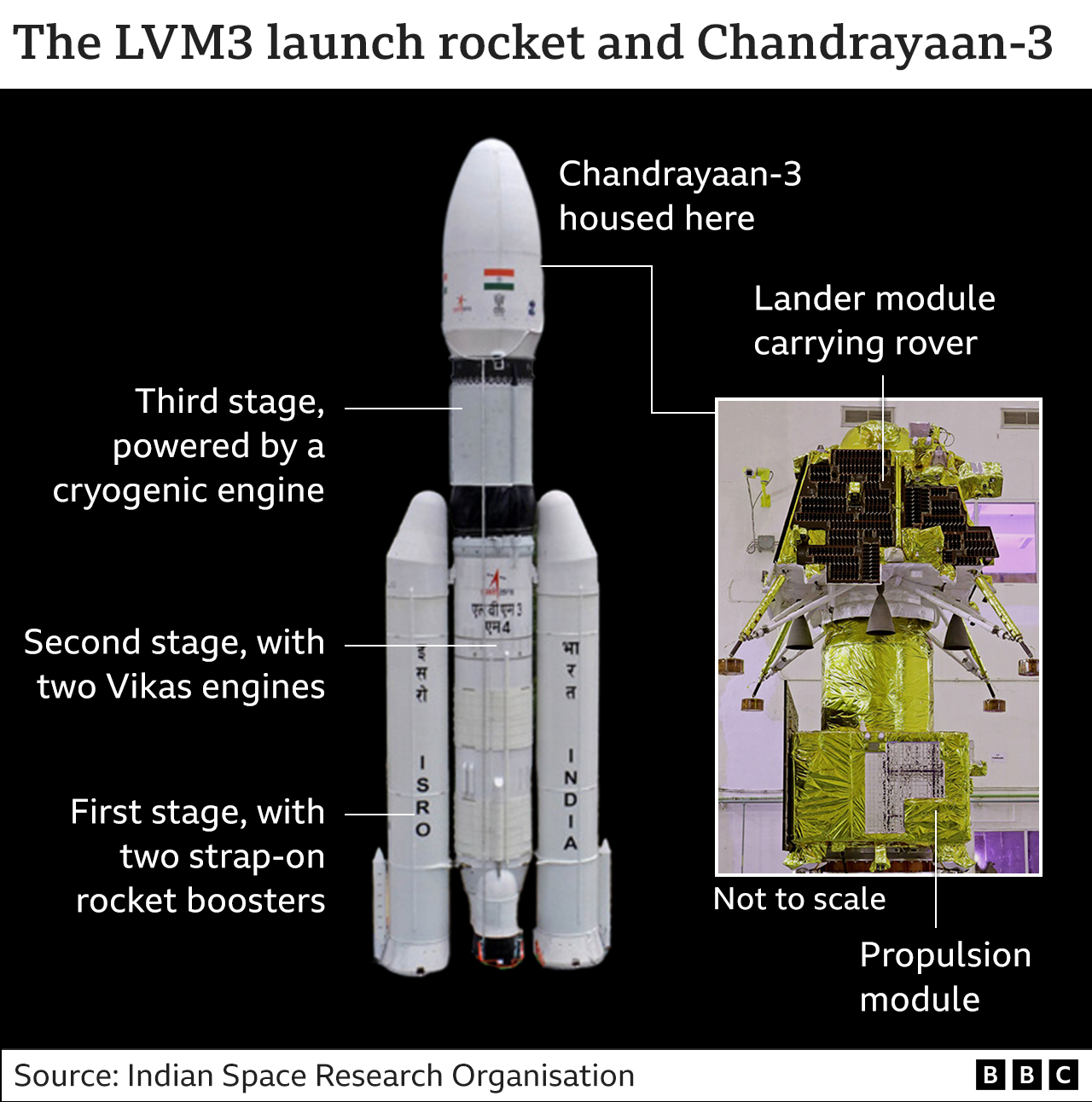Ahmedabad
(Head Office)Address : 506, 3rd EYE THREE (III), Opp. Induben Khakhrawala, Girish Cold Drink Cross Road, CG Road, Navrangpura, Ahmedabad, 380009.
Mobile : 8469231587 / 9586028957
Telephone : 079-40098991
E-mail: dics.upsc@gmail.com

Chandrayaan-3
News: India’s third mission to moon will take off today at 14:35 hours.
Background:
• The mission aims to achieve what its predecessor could not — land softly on the lunar surface and explore it with a rover.
• In this article we will discuss about the mission, what are the lessons learnt from past failure and what changes are incorporated in Chandrayaan-3.
What will be the approach?
• Isro chairperson S Somanath recently said the changes to the current mission were “failure-based.” Instead of a success-based design in Chandrayaan-2, a failure-based design in Chandrayaan-3 is carried out —so what can go wrong and how to deal with it is the focus.
• Last time the lander and rover had crashed rather than landing softly as 5 engines exerted a higher thrust than expected which eventually led to its implosion.
What changes have been made?
• One, the landing area has been expanded. Instead of trying to reach a specific 500mx500m patch for landing as targeted by Chandrayaan-2, the current mission has been given instructions to land safely anywhere in a 4kmx2.4km area. (You need not remember the area but focus on what steps have been taken. Use such examples in your answers wherever possible)
• Second, the lander has been provided more fuel so it can travel longer distances to the landing site or an alternate landing site, if need be.
• Third, the lander will no longer depend only on the pictures it clicks during the descent to determine a landing site. High resolution images from the Chandrayaan-2 orbiter have been fed into the lander and it will click images just to confirm that it has reached the correct location.
• Lastly, changes have also been made to the physical structure of the lander. The central thruster on the lander has been removed, reducing the number from five to four. The legs have been made sturdier to ensure it can land even at a higher velocity. More solar panels have been added to the body of the lander.
What are the names of different payloads? What will they do?
The lander module carries four payloads that will commence scientific experiments upon touchdown on the lunar surface.
• Radio Anatomy of Moon Bound Hypersensitive ionosphere and Atmosphere (RAMBHA) to study the plasma environment near the moon.
• Chandra’s Surface Thermophysical Experiment (ChaSTE) to measure thermal conductivity and temperature on the surface.
• Instrument for Lunar Seismic Activity (ILSA) to detect moonquakes.
• Laser Retroreflector Array (LRA) from NASA to measure distances using laser ranging.
The rover module carries two payloads that will perform in-situ analysis of the lunar soil.
• Alpha Particle X-Ray Spectrometer (APXS) to determine the elemental composition of the surface.
• Laser Induced Breakdown Spectroscope (LIBS) to identify the elements present in the soil.
What experiments will the mission carry out?
• There will be four scientific payloads on the lander to study lunar quakes, thermal properties of the lunar surface, changes in the plasma near the surface, and a passive experiment to help accurately measure the distance between Earth and moon.
• There are two payloads on the rover, designed to study the chemical and mineral composition of the lunar surface and to determine the composition of elements such as magnesium, aluminium and iron in the lunar soil and rocks.
• A new experiment has been tacked on to the propulsion module that will remain in orbit around the moon for three to six months. Called Spectro-polarimetry of Habitable Planet Earth (SHAPE), it will look for smaller planets that might be habitable in the reflected light.
Source – Indian Express, ISRO

Address : 506, 3rd EYE THREE (III), Opp. Induben Khakhrawala, Girish Cold Drink Cross Road, CG Road, Navrangpura, Ahmedabad, 380009.
Mobile : 8469231587 / 9586028957
Telephone : 079-40098991
E-mail: dics.upsc@gmail.com
Address: A-306, The Landmark, Urjanagar-1, Opp. Spicy Street, Kudasan – Por Road, Kudasan, Gandhinagar – 382421
Mobile : 9723832444 / 9723932444
E-mail: dics.gnagar@gmail.com
Address: 2nd Floor, 9 Shivali Society, L&T Circle, opp. Ratri Bazar, Karelibaugh, Vadodara, 390018
Mobile : 9725692037 / 9725692054
E-mail: dics.vadodara@gmail.com
Address: 403, Raj Victoria, Opp. Pal Walkway, Near Galaxy Circle, Pal, Surat-394510
Mobile : 8401031583 / 8401031587
E-mail: dics.surat@gmail.com
Address: 303,305 K 158 Complex Above Magson, Sindhubhavan Road Ahmedabad-380059
Mobile : 9974751177 / 8469231587
E-mail: dicssbr@gmail.com
Address: 57/17, 2nd Floor, Old Rajinder Nagar Market, Bada Bazaar Marg, Delhi-60
Mobile : 9104830862 / 9104830865
E-mail: dics.newdelhi@gmail.com